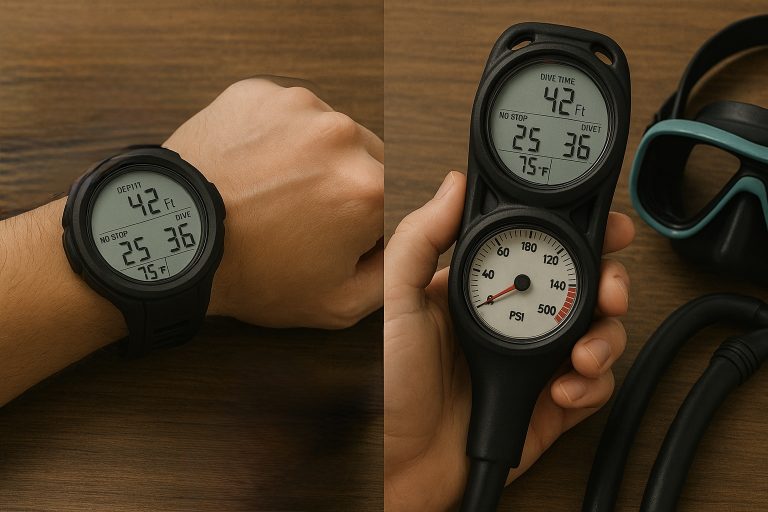- Understanding the Need for Proper Mask Care
- Pre-Treating New Dive Masks
- Cleaning Techniques for Silicone Masks
- Cleaning Techniques for Tempered-Glass Masks
- Regular Defogging Practices
- Storage and Maintenance Tips
- Handling and Transporting Your Mask
- Troubleshooting Common Problems
- Frequently Asked Questions
- Enhancing Your Diving Experience Through Care
Understanding the Need for Proper Mask Care
Your diving mask is more than just a piece of equipment; it’s your window to the underwater world. Whether you’re exploring coral reefs or practicing freediving basics and safety techniques, a well-maintained mask can make the difference between a memorable dive and a frustrating experience filled with leaks and fogging issues.
Many divers underestimate the importance of proper mask maintenance, often discovering too late that their neglected equipment has developed problems that could have been easily prevented. The reality is that both silicone and tempered-glass masks require specific care routines to perform at their best and maintain their longevity.
Why Care for Your Mask?
Regular maintenance of your diving mask serves multiple purposes beyond just keeping it clean. Proper care prevents the buildup of salt deposits, organic matter, and manufacturing residues that can compromise the mask’s seal and optical clarity. When you invest time in maintaining your mask, you’re essentially protecting your investment and ensuring consistent performance dive after dive.
The materials used in modern diving masks are designed to withstand harsh marine environments, but they still require attention to maintain their properties. Silicone skirts can degrade over time when exposed to UV light and salt water, while tempered glass lenses can develop microscopic scratches that affect visibility if not properly cared for.
Common Issues with Scuba Masks
Fogging represents the most frequent complaint among divers, often caused by a thin silicone film left over from the manufacturing process. This invisible layer prevents proper adhesion of anti-fog treatments, leading to persistent visibility problems underwater. Additionally, improper cleaning can leave residues that actually attract moisture and organic growth.
Leaking issues typically develop gradually as mask skirts lose their flexibility or develop small tears from improper handling. Many divers don’t realize that seemingly minor damage to the silicone seal can significantly impact the mask’s ability to maintain a watertight seal during dives.
Benefits of Proper Maintenance
A well-maintained mask provides crystal-clear vision throughout your dive, allowing you to fully appreciate the underwater environment without constantly clearing fog or adjusting your position to compensate for leaks. Proper care also extends the lifespan of your equipment, saving money in the long run by preventing premature replacement.
Regular maintenance routines help you become familiar with your equipment, making it easier to spot potential issues before they become serious problems. This familiarity also improves your overall diving experience, as you’ll have complete confidence in your gear’s performance.
Pre-Treating New Dive Masks
Every new diving mask requires pre-treatment before its first use, regardless of brand or price point. This crucial step removes manufacturing residues that would otherwise cause persistent fogging problems throughout the mask’s lifespan. Skipping this process is one of the most common mistakes new divers make.
The pre-treatment process specifically targets the silicone film deposited during manufacturing, which creates an invisible barrier on the glass surface. This film prevents proper wetting of the lens surface, causing water droplets to form instead of creating a clear, uniform layer that maintains visibility.
Importance of Pre-Treatment
Manufacturing processes inevitably leave microscopic residues on mask lenses, particularly silicone compounds used in molding and assembly. These residues are chemically bonded to the glass surface and cannot be removed through simple rinsing or standard cleaning methods. Without proper pre-treatment, even the best commercial defoggers will fail to provide lasting results.
The pre-treatment process essentially prepares the lens surface to accept anti-fog treatments properly. By removing these manufacturing residues, you create a clean surface that allows defogging agents to work as intended, providing clear vision throughout your dive.
Recommended Pre-Treatment Method
The most effective pre-treatment method involves using plain white toothpaste applied to completely dry lenses. Apply a small amount of non-gel toothpaste to the inside surface of each lens, then gently rub in circular motions using your finger or a soft cloth. The mild abrasive properties of toothpaste help break down the silicone film without damaging the glass.
After thoroughly rubbing the toothpaste across the entire lens surface, rinse completely with fresh water, ensuring no residue remains. This process should be repeated five to seven times for optimal results. Each application helps remove additional layers of manufacturing residue, gradually improving the lens surface’s ability to resist fogging.
Cautions Against Abrasive Cleaners
While toothpaste provides the right level of mild abrasiveness for glass lenses, stronger abrasive cleaners can cause permanent damage to your mask. Products like SoftScrub or other household cleaners containing harsh abrasives can scratch tempered glass, creating permanent cloudiness that cannot be repaired.
Fire-based cleaning methods, sometimes suggested in online forums, pose serious safety risks and can damage both glass and silicone components. These extreme methods can cause thermal stress in tempered glass, leading to cracks or complete failure of the lens.
Cleaning Techniques for Silicone Masks
Silicone mask skirts require gentle cleaning methods that preserve the material’s flexibility and sealing properties. The key is removing salt deposits, organic matter, and sunscreen residues without using harsh chemicals that could degrade the silicone over time.
Regular cleaning after each dive prevents the accumulation of contaminants that can cause premature aging of the silicone material. Salt crystals, in particular, can create microscopic cuts in the silicone surface if allowed to build up over time.
Using Toothpaste for Cleaning
Plain white toothpaste works effectively for cleaning silicone mask skirts, providing gentle abrasive action that removes stubborn deposits without damaging the material. Apply a small amount to the silicone areas and gently work it in with your fingers, paying special attention to areas where the skirt contacts your face.
The cleaning action should be gentle and methodical, avoiding excessive pressure that could stretch or tear the silicone. Focus on removing visible deposits and discoloration while maintaining the smooth surface texture that ensures proper sealing against your face.
Alternative Cleaning Methods
Mild dish soap mixed with warm water provides an excellent alternative for regular cleaning of silicone masks. This method is particularly effective for removing oils and organic residues that can accumulate during extended diving sessions. Create a gentle solution and use a soft brush to clean textured areas of the skirt.
Baby shampoo offers another gentle cleaning option, particularly for divers with sensitive skin who may react to stronger cleaning agents. Its mild formulation effectively removes contaminants while being gentle on both the silicone material and your skin during subsequent use.
Community Recommendations and Tips
Experienced divers often recommend soaking silicone masks in warm, soapy water for several minutes before cleaning, as this helps soften stubborn deposits and makes removal easier. This technique is particularly useful after diving in areas with heavy organic growth or industrial pollution.
Some diving communities suggest using a mixture of white vinegar and water for periodic deep cleaning of silicone components. This natural solution helps dissolve mineral deposits and organic buildup without introducing harsh chemicals that could affect the silicone’s properties.
Cleaning Techniques for Tempered-Glass Masks
Tempered-glass lenses require specific cleaning approaches that maintain optical clarity while preventing damage to the specially treated surface. The key is using methods that effectively remove contaminants without creating microscopic scratches that can accumulate over time and affect visibility.
Glass lenses are generally more resistant to chemical damage than plastic alternatives, but they can still be permanently damaged by improper cleaning techniques or abrasive materials. Understanding the proper approach ensures your mask maintains crystal-clear optics throughout its service life.
Best Practices for Glass Lenses
Clean glass lenses immediately after each dive to prevent salt deposits from crystallizing and becoming more difficult to remove. Use fresh water to rinse away salt and organic matter, then apply appropriate cleaning agents to address any remaining residues or films.
When cleaning glass lenses, always work from the center outward in gentle circular motions. This technique prevents the concentration of cleaning pressure in any single area and reduces the risk of creating scratches or stress points in the glass surface.
Avoiding Damage to Glass Masks
Never use paper towels, tissues, or rough cloths on glass lenses, as these materials can contain wood fibers or other abrasive particles that create microscopic scratches. Instead, use clean, soft cloths specifically designed for optical surfaces, or allow the mask to air dry when possible.
Avoid exposing glass lenses to extreme temperature changes, such as rinsing with very hot water immediately after a cold dive. Sudden temperature changes can create thermal stress in tempered glass, potentially leading to cracks or complete lens failure.
Tips from Experienced Divers
Many experienced divers recommend keeping a dedicated lens cleaning cloth in their dive kit, stored in a clean, dry container to prevent contamination. This ensures you always have appropriate cleaning materials available and reduces the temptation to use whatever cloth happens to be handy.
Professional dive instructors often suggest inspecting glass lenses under good lighting after cleaning to identify any developing issues early. Small scratches or chips that might not be noticeable underwater can often be spotted during careful inspection and addressed before they become serious problems.
Regular Defogging Practices
Effective defogging is essential for maintaining clear vision throughout your dive, regardless of how well you’ve pre-treated your mask. Understanding the science behind fogging and the various prevention methods available helps you choose the most effective approach for your diving conditions.
Fogging occurs when water vapor condenses on the lens surface, forming tiny droplets that scatter light and reduce visibility. The key to prevention is creating a surface condition that promotes uniform water distribution rather than droplet formation.
Why Defogging is Necessary
Even properly pre-treated masks will eventually develop fogging issues due to the gradual accumulation of oils, salts, and organic matter on the lens surface. These contaminants create nucleation sites where water droplets can form, gradually reducing the effectiveness of your initial pre-treatment.
Environmental factors such as temperature differences between the water and your mask’s interior also contribute to fogging. When warm, moist air from your breathing contacts the cooler lens surface, condensation naturally occurs unless preventive measures are in place.
Methods for Defogging Before Dives
The most reliable defogging method involves applying a thin layer of commercial defogger to clean, dry lenses, then rinsing lightly with water to remove excess product while leaving a protective film. This film helps water spread evenly across the lens surface rather than forming individual droplets.
Application technique is crucial for defogger effectiveness. Apply the product evenly across the entire lens surface, including corners and edges where fogging often begins. Allow the defogger to work for the recommended time before rinsing, as rushing this process reduces its effectiveness.
Using Saliva and Commercial Defoggers
Saliva remains one of the most readily available and effective defogging agents, containing natural surfactants that reduce surface tension and promote even water distribution. Apply saliva to dry lenses, spread evenly with your finger, then rinse lightly with water before putting on the mask.
Commercial defoggers offer more consistent results and longer-lasting protection than saliva, particularly in challenging conditions. These products are specifically formulated to provide optimal surface tension reduction while being safe for use around your eyes and in marine environments.
Storage and Maintenance Tips
Proper storage significantly impacts your mask’s longevity and performance, protecting it from environmental damage and maintaining the integrity of both silicone and glass components. Whether you’re storing your mask between dives or for extended periods, following proper procedures prevents common problems that can develop over time.
When selecting storage solutions, consider factors such as UV protection, ventilation, and protection from physical damage. The best storage practices address all these concerns while keeping your mask easily accessible for your next diving adventure. Many divers who invest in quality snorkel masks for optimal field of view understand that proper storage is just as important as the initial equipment selection.
Proper Storage Techniques
Store your mask in a cool, dry location away from direct sunlight, as UV radiation can degrade silicone materials over time and cause discoloration or brittleness. A dedicated mask box or padded case provides excellent protection while allowing air circulation that prevents moisture buildup.
Avoid storing your mask in compressed positions that could deform the silicone skirt or create stress points in the glass. Lay the mask flat or hang it by the strap in a way that maintains its natural shape and prevents long-term deformation of sealing surfaces.
Inspecting Your Mask Regularly
Develop a routine inspection schedule that includes checking for small tears in the silicone, scratches on the lens, and signs of strap deterioration. Early detection of these issues allows for timely repairs or replacement before problems affect your diving safety or enjoyment.
Pay particular attention to the areas where the silicone skirt meets the lens frame, as this junction experiences significant stress during use and is prone to developing small tears that can gradually worsen. Regular inspection helps identify these issues while they’re still manageable.
When to Replace Your Mask
Replace your mask when the silicone skirt develops tears that cannot be effectively repaired, when lens scratches significantly impact visibility, or when the overall fit becomes compromised due to material degradation. These safety-related issues should never be ignored or temporarily patched.
Consider replacement when your mask no longer maintains a reliable seal despite proper maintenance and fitting adjustments. A mask that requires constant attention to prevent leaking has reached the end of its useful service life and should be retired.
Handling and Transporting Your Mask
Careful handling during transport protects your mask from damage while ensuring it arrives at your diving destination in perfect condition. Whether you’re traveling to local dive sites or exotic locations for snorkeling adventures, proper transport techniques prevent common problems that can ruin a diving trip.
The key to successful mask transport is providing adequate protection while maintaining accessibility for pre-dive preparation. This balance requires thoughtful packing techniques and appropriate protective equipment designed specifically for diving gear.
Best Practices for Transporting Masks
Always transport your mask in a rigid case or well-padded compartment that prevents crushing and protects the lens from scratches. Avoid packing heavy items on top of your mask, as pressure can deform the silicone skirt or create stress fractures in tempered glass lenses.
When packing multiple pieces of diving equipment together, use soft separators or individual protective sleeves to prevent items from rubbing against each other during transport. This is particularly important when traveling with other gear that might have sharp edges or rough surfaces.
Avoiding Damage During Travel
Remove or secure loose straps and accessories that could catch on other items or become tangled during transport. Strap buckles and adjustment mechanisms are particularly vulnerable to damage when allowed to move freely within luggage or equipment bags.
Consider the environmental conditions your mask will encounter during transport, including temperature extremes and humidity changes. Gradual acclimatization helps prevent thermal stress in glass components and reduces the risk of condensation forming inside protective cases.
Protecting Your Mask from Environmental Factors
Shield your mask from prolonged exposure to high temperatures, such as those found in car trunks or direct sunlight during surface intervals. Excessive heat can accelerate silicone degradation and create thermal stress in glass lenses that may not become apparent until later use.
Protect your mask from sand and salt spray during surface intervals by storing it in a closed case or sealed bag. These environmental contaminants can cause significant damage if allowed to accumulate on lens surfaces or within the silicone skirt.
Troubleshooting Common Problems
Even with proper care and maintenance, diving masks can develop issues that require specific troubleshooting approaches. Understanding how to identify and address common problems helps you maintain optimal performance and extend your equipment’s service life. These skills become particularly valuable when combined with proper breath-hold training techniques, as equipment reliability is crucial for safe diving practices.
Effective troubleshooting begins with accurate problem identification, followed by systematic approaches to resolution. Many issues that initially appear serious can be resolved with simple adjustments or cleaning procedures, while others may indicate the need for equipment replacement.
Identifying Fogging Issues
Persistent fogging despite proper pre-treatment usually indicates incomplete removal of manufacturing residues or the accumulation of new contaminants on the lens surface. This problem requires returning to the pre-treatment process or implementing more aggressive cleaning procedures to restore proper surface conditions.
Intermittent fogging that occurs only under specific conditions may be related to environmental factors such as extreme temperature differences or high humidity levels. Understanding these patterns helps you adjust your defogging routine to address the specific conditions you encounter during your dives.
Dealing with Leaks
Small leaks often result from improper mask positioning rather than equipment failure. Ensure the silicone skirt contacts your face evenly without gaps, and avoid over-tightening the strap, which can actually create seal problems by distorting the skirt’s natural shape.
Persistent leaking despite proper fitting may indicate damage to the silicone skirt or frame distortion that prevents proper sealing. Carefully inspect the entire sealing surface for tears, permanent deformation, or foreign matter that could compromise the seal.
Adjusting Fit for Comfort
Proper mask fit balances comfort with effective sealing, requiring careful adjustment of strap tension and positioning. The mask should seal against your face with minimal strap pressure, relying primarily on the silicone skirt’s design to maintain the watertight barrier.
If your mask consistently leaves marks or causes discomfort, consider whether the size or style is appropriate for your facial structure. Sometimes switching to a different mask design provides better comfort and sealing performance than attempting to force an incompatible mask to work properly.
Frequently Asked Questions
Why is it important to care for my diving mask?
Proper care prevents issues like fogging and leaks, ensuring optimal visibility and performance during dives.
What is the recommended method for pre-treating a new diving mask?
Using plain white toothpaste to gently scrub the inside of the lenses is the best method to remove manufacturing residues.
How often should I clean my diving mask?
It’s recommended to clean your mask after each dive to prevent the buildup of salt and organic matter.
What should I avoid when cleaning tempered-glass lenses?
Avoid using paper towels or abrasive materials that can scratch the glass, and be cautious of extreme temperature changes.
How can I prevent my mask from fogging during a dive?
Apply a commercial defogger or saliva to the dry lenses before putting on the mask to create a protective film.
Enhancing Your Diving Experience Through Care
By following the maintenance tips outlined in this article, divers can significantly enhance their underwater experience. Proper care not only extends the life of your equipment but also ensures that you can fully enjoy the beauty of the underwater world without the distraction of fogged lenses or leaks.





